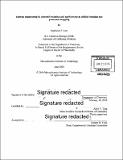Enzyme engineering by directed evolution and applications in cellular imaging and proteomic mapping
Author(s)
Lam, Stephanie S. (Stephanie Shih-Min)
DownloadFull printable version (26.25Mb)
Other Contributors
Massachusetts Institute of Technology. Department of Chemistry.
Advisor
Alice Y. Ting.
Terms of use
Metadata
Show full item recordAbstract
A thorough understanding of biological systems on a molecular level requires tools to study individual protein components within the native cellular context. A wide panoply of enzyme-mediated labeling methodologies have been developed that couple the power of enzyme specificity with the functional diversity of small molecules to specifically tag proteins within the crowded heterogeneous intracellular environment for a wide array of applications including imaging by fluorescence or electron microscopy, and isolation and identification by mass spectrometry. Towards this end, a common theme in the design of new enzyme tools has been the repurposing of enzymes away from their natural chemical substrates to derivatives that provide more useful properties such as fluorescence or high-affinity handles. Many current directed evolution methods focus on the detection of product formation, but have limited ability to address improvements in catalytic efficiency. As a result, many of the developed methods may work in permissive proof-of-concept demonstrations in model cell lines under overexpression conditions, but lack sufficient activity to generate detectable signal in more relevant biological systems in which enzyme expression levels are more restricted. The goal of this thesis is to explore the development and application of directed evolution methods towards the challenging problem of improving enzyme catalysis. We attempted to design a new phage-display directed evolution platform for improving enzyme turnover of the E. coli biotin ligase BirA, but found that our separation based on ultracentrifugation lacked the necessary sensitivity to discriminate between levels of enzyme turnover. We also looked at applications of the specific labeling of BirA and promiscuous labeling of horseradish peroxidase towards capturing fluorescent live cellular migration tracks on the traversed extracellular matrix. We then utilized yeast display to develop a selection method for evolving peroxidases with improved activity to address the sensitivity limitations of the previously developed enhanced ascorbate peroxidase (APEX) tag from the Ting lab used for electron microscopy and spatial proteomics. This led to the successful discovery and characterization of the highly-active APEX2 which enabled advancements in mitochondrial and mitochondria-endoplasmic reticulum junction biology.
Description
Thesis: Ph. D., Massachusetts Institute of Technology, Department of Chemistry, 2016. Cataloged from PDF version of thesis. Includes bibliographical references.
Date issued
2016Department
Massachusetts Institute of Technology. Department of ChemistryPublisher
Massachusetts Institute of Technology
Keywords
Chemistry.